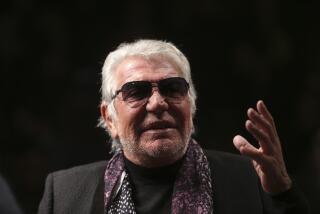The Rise and Fall of the Halston Name
- Share via
Roy Halston Frowick was America’s first celebrity designer. He was as much an icon of the ‘70s and ‘80s himself as were his cashmere twin sets, jersey gowns and love of Ultrasuede. But he was not a businessman. By the time Halston died of complications of AIDS in 1990, his name had been sold so many times that he ultimately had no control over the use of it.
“Halston is the, not one of the, preeminent American designer,” says Constance White, fashion director of the new Talk magazine. “He not only was dominant in his time, but his clothing, his designs have stood the test of time.”
Halston was the first American designer to capitalize on his fame, becoming a brand by licensing his name on a massive scale.
The Halston name gave immediate cachet to products. In 1973, the designer went into a partnership with Norton Simon Industries, which put the Halston name on a range of goods, from casual blouses to perfume.
Then in 1982 Halston entered an agreement to design clothes for J.C. Penney Co. The exclusive stores that had been carrying his clothes dropped him immediately. Many saw that as the beginning of his personal demise as well.
Though Halston said that he wanted to design for all American women, many believed that the free-spending, free-spirited designer simply needed the money, according to “Simply Halston” by Steven Gaines (G.P. Putnam’s Sons, 1991).
After a series of leveraged buyouts in the 1980s, the Halston name ended up belonging to Revlon, which actually paid the famous designer not to participate in the business or its designs.
Revlon sold Halston perfume to Borghese, which sold it to the French Fragrance Co., said Nicholas DeMarco, CEO and president of Halston Newco, which owns the Halston name for clothing.
Without Halston, his clothes lost their charm. The Halston clothing line ceased to exist in 1990 and did not return until the licensing was bought in 1996 by Tropic Tex International. With sportswear designer Randolph Duke at the creative helm, the Halston name became respected again.
But just two years later, Tropic Tex closed the sportswear division of Halston Newco and the company went from 300 to 30 employees. The Halston name for clothing was sold again, to Catterton-Simon Partners. Duke left soon after.
DeMarco says an important lesson was learned from past owners of the brand. All licensed clothing products will be introduced slowly after each new line is established, he says.
Even after his death, Halston remains a force in the design world. Says White, “So many designers have been inspired by him, most prominently Tom Ford of Gucci.”
Halston is one of a handful of American designers whose work museums want to collect, says Rita Watnick, owner of Lily, a Beverly Hills vintage store.
Lily’s current Halston collection chronicles the designer’s peak and downfall. The Halston gowns are beautiful and timeless--one is crafted from multicolored panels, another from three layers of red chiffon. And a rather dowdy mass-produced black beaded dress illustrates the fact that Halston himself began to cheapen his name, long before he lost the use of it.
*
Times researcher Penny Love contributed to this report.






